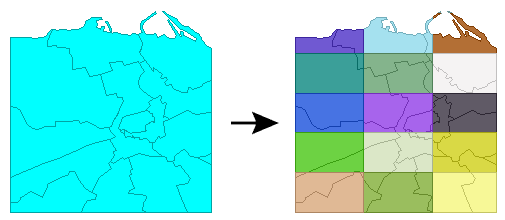Chops the input features into a series of tiles.
Features that span multiple tiles will be clipped into multiple features. Features that lie on the boundary between tiles will be output once in each tile. If this is not the desired behavior a DuplicateFilter transformer can be used.
This transformer works with raster, vector and point cloud data.
Note: If you are inputting raster data, you may want to use the RasterTiler instead. The following table compares the Tiler and the RasterTiler:
| Tiler | RasterTiler | |
|---|---|---|
| Type of data accepted | All types | Raster only |
| Tile size units | Ground coordinates | Pixel coordinates |
| Tile row numbering (0, 1,...) | Bottom to top | Top to bottom |
| Supports forcing equal-size tiles | No | Yes |
| Supports raster index attribute | No | Yes |
| Supports number of horizontal/vertical tiles attribute | No | Yes |
Parameters
Transformer
If Group By attributes are selected, features with the same values in the Group By attributes are placed into the same set, and clipping occurs in each set independent of other sets.
Tile Parameters
Tile Size: This option enables the Tile Width and Height parameters, which allow you to specify the width and height of each tile in ground units.
Number of Tiles: This option enables the Number of Horizontal and Vertical Tiles parameters, which allow you to specify the number of tiles that will be produced.
Tile Size
These parameters are required when the Tiling Type is Tile Size, and allow you to specify the size of each tile in ground units (for example, 100m x 100m).
Note: If the source is a raster, does not have a coordinate system and is not georeferenced, then the raster extents and spacing are adjusted to default values. The horizontal and vertical spacing are set to one column and one row, respectively, and the origin is set to (0,0).
Note: IMPORTANT: If attributes are used for the Tile Width or Tile Height parameters, the value will be taken from the first feature to enter the transformer. An error will occur if this feature does not have these attributes.
These optional parameters specify a "seed point" from which tiles will be generated. Note that it is permissible to specify a value for only one of these parameters—not necessarily both.
Number of Tiles
These parameters are required when the Tiling Type is Number of Tiles, and allow you to specify how to tile the input data (for example, 5 horizontal tiles and 5 vertical tiles).
Chooses a starting corner for the purposes of numbering rows and columns. Also, when Tiling Type is Tile Size, the last row and/or the last column may extend beyond the bounds of the input features; here the “last” row or column is the one opposite the Starting Corner.
This parameter allows elements along the border of more than one tile to be duplicated and added to each tile that they touch.
This value is used with the Default Value Measures/Z Conflict Mode to flag missing measures and z values.
When using the Compute mode to compute missing measure values, measures can be considered Continuous, and linearly interpolated from their neighbors, or they can be Discrete, and taken exactly from the nearest neighbor.
If set to Yes, then contiguous lines that constitute the boundary of the output features will be left as separate segments in a path. The default is No, which means that such lines will be joined into longer lines in the output unless they have different properties (for example, traits, measures, and geometry name).
Attributes
Each feature output from the Tiler will have a row and a column attribute added, specifying the zero-based row and column that the feature fell into. Row 0, Column 0 corresponds to the tile in the bottom-left corner.
Example

Editing Transformer Parameters
Using a set of menu options, transformer parameters can be assigned by referencing other elements in the workspace. More advanced functions, such as an advanced editor and an arithmetic editor, are also available in some transformers. To access a menu of these options, click  beside the applicable parameter. For more information, see Transformer Parameter Menu Options.
beside the applicable parameter. For more information, see Transformer Parameter Menu Options.
Transformer Categories
Search FME Knowledge Center
Search for samples and information about this transformer on the FME Knowledge Center.
Tags Keywords: raster grid clip subset tile extent bound limit Tessellate Tessellation pointcloud